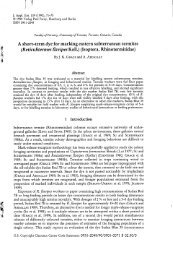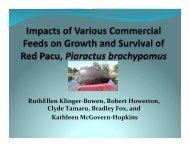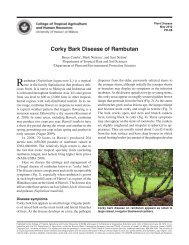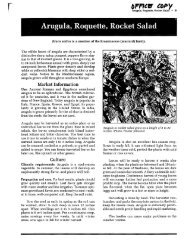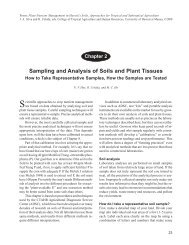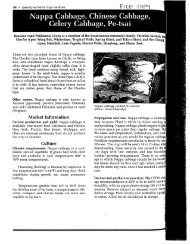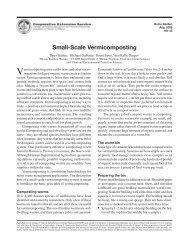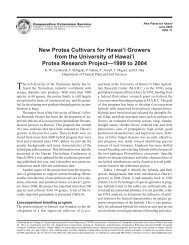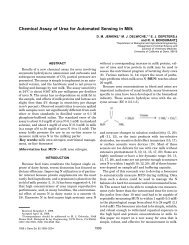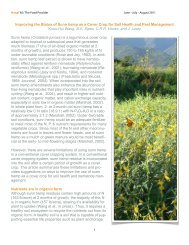Citrus Tristeza Virus in Hawai'i - ctahr
Citrus Tristeza Virus in Hawai'i - ctahr
Citrus Tristeza Virus in Hawai'i - ctahr
You also want an ePaper? Increase the reach of your titles
YUMPU automatically turns print PDFs into web optimized ePapers that Google loves.
<strong>Citrus</strong> tristeza virus (CTV)<br />
is the most economically<br />
important pathogen of citrus<br />
worldwide (Figure 1). CTV is<br />
the causal agent of “tristeza”<br />
(also known as “quick decl<strong>in</strong>e”),<br />
which has destroyed over 50<br />
million citrus trees grow<strong>in</strong>g on<br />
sour orange rootstocks globally<br />
(Figure 2). CTV is also responsible<br />
for another viral disease<br />
known as stem pitt<strong>in</strong>g (Figures<br />
3, 4, 5) which reduces fruit quality<br />
and negatively impacts the<br />
production of limes, grapefruits,<br />
and sweet oranges (Figures 6, 7)<br />
(72). Numerous stra<strong>in</strong>s of CTV<br />
exist. Mild stra<strong>in</strong>s that <strong>in</strong>fect<br />
sweet orange, mandar<strong>in</strong>s, and<br />
<strong>Citrus</strong> <strong>Tristeza</strong> <strong>Virus</strong> <strong>in</strong> Hawai‘i<br />
Scot Nelson, Michael Melzer, and John Hu<br />
Department of Plant and Environmental Protection Sciences<br />
many other cultivars sometimes do not cause symptoms<br />
and result <strong>in</strong> less severe crop losses. CTV is vectored<br />
by multiple aphid species <strong>in</strong> Hawai‘i (Figures 8, 9, 10),<br />
where it poses a cont<strong>in</strong>u<strong>in</strong>g threat to citrus cultivation<br />
throughout the state. Here we discuss CTV, the diseases it<br />
causes, and some <strong>in</strong>tegrated practices for its management.<br />
Hawai‘i imported nearly 20 million pounds of fresh<br />
citrus fruits <strong>in</strong> 2008, while produc<strong>in</strong>g only a few hundred<br />
thousand pounds of fresh citrus for local markets (71)<br />
(Table 1). Although Hawai‘i possesses a favorable climate<br />
for citrus cultivation, citrus farm<strong>in</strong>g ranks relatively low<br />
<strong>in</strong> crop value and total acreage among agricultural commodities.<br />
Among the factors contribut<strong>in</strong>g to the paucity<br />
of productive citrus farms <strong>in</strong> Hawai‘i are plant diseases,<br />
<strong>in</strong> particular tristeza and stem pitt<strong>in</strong>g caused by CTV.<br />
Figure 1. <strong>Tristeza</strong> or quick decl<strong>in</strong>e caused by <strong>Citrus</strong><br />
tristeza virus <strong>in</strong> citrus grown on a sour orange<br />
rootstock. Photograph courtesy of S. M. Garnsey,<br />
University of Florida.<br />
Plant Disease<br />
September 2011<br />
PD-77<br />
Farmers <strong>in</strong> Brazil co<strong>in</strong>ed the<br />
disease name “tristeza,” which<br />
means “sadness” <strong>in</strong> Portuguese,<br />
because of the severity<br />
of symptoms and the large crop<br />
losses caused there by the virus<br />
<strong>in</strong> the 1930s.<br />
The pathogen, CTV<br />
When, how, or from where<br />
CTV first entered Hawai‘i is<br />
unknown. However, the first<br />
report of tristeza and stem<br />
pitt<strong>in</strong>g <strong>in</strong> the Islands was at<br />
the University of Hawai‘i at<br />
Mānoa’s Poamoho Agricultural<br />
Experiment Station on<br />
the island of O‘ahu <strong>in</strong> 1952 (33)<br />
(Table 2). A subsequent survey<br />
of citrus trees elsewhere on O‘ahu <strong>in</strong>dicated that disease<br />
symptoms caused by CTV were widespread <strong>in</strong> citrus<br />
throughout Hawai‘i.<br />
CTV is a member of the virus family Closteroviridae,<br />
genus Closterovirus, of which Beet yellows virus<br />
(BYV) is the type member. Several review articles and<br />
book chapters have focused on this virus family (1, 2, 16,<br />
44) or specifically on CTV (29, 49, 58). The closteroviruses<br />
are positive-strand RNA viruses with long, flexuous<br />
particles. A typical CTV particle is approximately<br />
2000 nm <strong>in</strong> length and 12 nm <strong>in</strong> diameter (Figure 11).<br />
CTV is limited to the phloem tissues of <strong>in</strong>fected hosts.<br />
The natural host range for CTV is conf<strong>in</strong>ed to members<br />
of the plant family Rutaceae, of which citrus species are<br />
members (Tables 3, 4). Some Passiflora species are the<br />
Published by the College of Tropical Agriculture and Human Resources (CTAHR) and issued <strong>in</strong> furtherance of Cooperative Extension work, Acts of May 8 and June 30, 1914, <strong>in</strong> cooperation<br />
with the U.S. Department of Agriculture, under the Director/Dean, Cooperative Extension Service/CTAHR, University of Hawai‘i at Mānoa, Honolulu, Hawai‘i 96822.<br />
Copyright 2011, University of Hawai‘i. For reproduction and use permission, contact the CTAHR Office of Communication Services, ocs@<strong>ctahr</strong>.hawaii.edu, 808-956-7036. The university is<br />
an equal opportunity/affirmative action <strong>in</strong>stitution provid<strong>in</strong>g programs and services to the people of Hawai‘i without regard to race, sex, gender identity and expression, age, religion, color,<br />
national orig<strong>in</strong>, ancestry, disability, marital status, arrest and court record, sexual orientation, or status as a covered veteran. F<strong>in</strong>d CTAHR publications at www.<strong>ctahr</strong>.hawaii.edu/freepubs.
UH–CTAHR <strong>Citrus</strong> <strong>Tristeza</strong> <strong>Virus</strong> <strong>in</strong> Hawai‘i PD-77 — Sept. 2011<br />
Table 1. Market supply of fresh citrus <strong>in</strong> Hawai‘i (2008)<br />
(from 71).<br />
2<br />
<strong>Citrus</strong><br />
Inshipments<br />
(Pounds)<br />
Produced <strong>in</strong> Hawai‘i<br />
(Pounds)<br />
Grapefruit 1,307,000 46,000<br />
Lemon 3,501,000 55,000<br />
Lime 1,957,000 76,000<br />
Orange 12,381,000 (data not available)<br />
Tanger<strong>in</strong>e 2,000,000 98,000<br />
Table 2. Quick decl<strong>in</strong>e and stem-pitt<strong>in</strong>g symptoms observed<br />
at the Poamoho Agricultural Experiment Station<br />
on the island of O‘ahu <strong>in</strong> 1952, the first report of tristeza<br />
disease <strong>in</strong> Hawai‘i (from 33).<br />
Disease<br />
Severity<br />
Severe 2<br />
Moderate<br />
Mild<br />
Unaffected<br />
(asymptomatic) 3<br />
<strong>Citrus</strong> Varieties and Types Exposed<br />
to CTV at Poamoho 1<br />
Lime: ‘Mexican’<br />
Limequat (cross between Key lime<br />
and kumquat)<br />
Lime: ‘Kusaie,’ ‘Rangpur’<br />
Mediterranean sweet orange<br />
Navel orange: ‘Golden Buckeye,’<br />
‘Wash<strong>in</strong>gton,’ ‘Carter’<br />
Grapefruit: ‘Marsh,’ ‘Davis,’ ‘Bowden,’<br />
‘Sunsh<strong>in</strong>e’<br />
Kumquat: ‘Nagami,’ ‘Nippon’<br />
Lemon: ‘Eureka,’ ‘Villafranca,’ ‘Meyer,’<br />
rough lemon<br />
Lime: Tahitian lime<br />
Mandar<strong>in</strong> orange: ‘Wase,’ ‘Kara’<br />
Orange: Hawaiian (Kona), ‘Valencia’<br />
1 All trees were grown on rough lemon rootstocks. The year<br />
of these data was 1952. 2 Severe symptoms <strong>in</strong>cluded stunted<br />
growth, distorted limbs, and stem pitt<strong>in</strong>g. 3 Lack of symptoms<br />
(unaffected) does not necessarily <strong>in</strong>dicate host resistance to CTV.<br />
only known non-rutaceous hosts (66).<br />
Numerous stra<strong>in</strong>s of CTV have been described<br />
that vary <strong>in</strong> virulence and the severity of the diseases<br />
they cause. Some stra<strong>in</strong>s of CTV cause tristeza, but not<br />
stem pitt<strong>in</strong>g. Similarly, some stra<strong>in</strong>s cause stem pitt<strong>in</strong>g<br />
<strong>in</strong> oranges, but not <strong>in</strong> grapefruit. The most reliable and<br />
Figure 2. Aerial view of a Florida citrus grove affected by<br />
tristeza or quick decl<strong>in</strong>e. Photograph courtesy of S. M.<br />
Garnsey, University of Florida.<br />
effective method for differentiat<strong>in</strong>g the CTV stra<strong>in</strong>s is<br />
through the use of <strong>in</strong>dicator plants (30, 74). Garnsey et<br />
al. (30) have developed a standardized bioassay for stra<strong>in</strong><br />
detection us<strong>in</strong>g the follow<strong>in</strong>g <strong>in</strong>dicator plants: ‘Mexican’<br />
lime, sour orange, ‘Duncan’ grapefruit, ‘Madam V<strong>in</strong>ous’<br />
sweet orange, and navel sweet orange on a sour orange<br />
rootstock. Symptom development <strong>in</strong> these <strong>in</strong>dicator<br />
plants follow<strong>in</strong>g <strong>in</strong>oculation with an unknown CTV<br />
stra<strong>in</strong> helps to determ<strong>in</strong>e whether the stra<strong>in</strong> can cause<br />
quick decl<strong>in</strong>e or stem pitt<strong>in</strong>g, as well as <strong>in</strong>dicat<strong>in</strong>g the<br />
severity of symptoms. Severe stra<strong>in</strong>s of CTV will cause<br />
tristeza and/or stem-pitt<strong>in</strong>g symptoms, whereas milder<br />
stra<strong>in</strong>s cause less severe disease or may <strong>in</strong>fect citrus<br />
plants asymptomatically. Some stra<strong>in</strong>s of CTV may<br />
<strong>in</strong>duce symptoms differentially <strong>in</strong> one host but not <strong>in</strong><br />
another (49).<br />
Based on the wide range of genetic marker patterns,<br />
a diverse population of CTV stra<strong>in</strong>s exists <strong>in</strong> Hawai‘i.<br />
Mixed <strong>in</strong>fections consist<strong>in</strong>g of various CTV stra<strong>in</strong>s<br />
also commonly occur <strong>in</strong> Hawaiian citrus; observed<br />
symptoms are usually caused by the more severe stra<strong>in</strong><br />
<strong>in</strong> the mixture.<br />
CTV is limited worldwide to tropical and subtropical<br />
regions. Currently, CTV is found <strong>in</strong> North America<br />
(35, 73), Central America and the Caribbean (35, 37, 79),<br />
South America (35), Australia (6), Oceania (33), Asia<br />
(56), Africa (49, 76), and some Mediterranean countries<br />
(7, 36, 49). CTV and the diseases it causes exist<br />
throughout the Hawaiian Islands, where the <strong>in</strong>cidence
UH–CTAHR <strong>Citrus</strong> <strong>Tristeza</strong> <strong>Virus</strong> <strong>in</strong> Hawai‘i PD-77 — Sept. 2011<br />
Figure 3. Compare the smooth stem of a healthy citrus<br />
tree (above) versus the stem pitt<strong>in</strong>g caused by <strong>Citrus</strong><br />
tristeza virus (CTV) (below). Peel back the epidermis of<br />
young stems to observe this symptom, which is diagnostic<br />
for this disease.<br />
of CTV-<strong>in</strong>fected citrus plants is high. Garnsey et al. (28)<br />
reported virus <strong>in</strong>cidence of 91% (41 out of 45 plants) on<br />
O‘ahu, Maui, and the island of Hawai‘i, although most<br />
of the samples tested appear to have spread from the<br />
Big Island. A recent and more comprehensive survey<br />
(52) found CTV <strong>in</strong>cidence of 74% (298 of 405 plants).<br />
Diseases caused by CTV and symptoms<br />
There are three pr<strong>in</strong>cipal diseases caused by CTV <strong>in</strong><br />
citrus trees: tristeza, stem pitt<strong>in</strong>g, and seedl<strong>in</strong>g yellows<br />
(Figure 12) (Table 5). The severity of these diseases is<br />
dependent on the stra<strong>in</strong> of CTV present and on the susceptibility<br />
of the host. <strong>Tristeza</strong> is a decl<strong>in</strong>e of different<br />
scion cultivars grafted onto sour orange rootstocks. This<br />
decl<strong>in</strong>e can occur over a period of several years, or <strong>in</strong><br />
only a few months (this rapid form of the disease is also<br />
known as “quick decl<strong>in</strong>e”). Trees with tristeza <strong>in</strong>itially<br />
appear water stressed; this stage is followed by defoliation<br />
and death. In Hawai‘i, tristeza is rarely encountered<br />
because sour orange rootstocks are no longer used.<br />
Stem pitt<strong>in</strong>g is a disease most commonly seen <strong>in</strong><br />
grapefruits, sweet oranges, and some lime cultivars.<br />
Trees with severe stem pitt<strong>in</strong>g appear stunted, with chlorotic<br />
leaves that often display “ve<strong>in</strong>-clear<strong>in</strong>g” symptoms<br />
(Figure 13). Twigs and small branches on these trees are<br />
brittle and can be snapped with little effort. When the<br />
bark is removed from twigs or branches, the wood will<br />
have small p<strong>in</strong>hole-like pits, or long grooves that give it<br />
Figure 4. Stem pitt<strong>in</strong>g caused by <strong>Citrus</strong> tristeza virus<br />
(CTV) <strong>in</strong> Mexican lime (C. aurantifolia): symptoms caused<br />
by a very mild stra<strong>in</strong> of CTV (above) versus a more severe<br />
CTV stra<strong>in</strong> (below).<br />
Table 3. Genera of the family Rutaceae, subfamily Aurantioidae,<br />
tribe Citrae, subtribe Citr<strong>in</strong>ae (from 69, 70).<br />
Genus<br />
Number of<br />
Species<br />
Geographic Orig<strong>in</strong><br />
Sever<strong>in</strong>ia 6 S Ch<strong>in</strong>a, SE Asia<br />
Pleiospermium 5 S Asia, Oceania<br />
Burkillanthus 1 SE Asia, Oceania<br />
Limnocitrus 1 SE Asia<br />
Hesperathusa 1 S and SE Asia<br />
Citropsis 11 Central Africa<br />
Atalantia 11 S and SE Asia<br />
Fortunella 4 S Ch<strong>in</strong>a<br />
Eremocitrus 1 Australia<br />
Poncirus 2 Central and N Ch<strong>in</strong>a<br />
Clymenia 1 Oceania<br />
Microcitrus 6 Australia<br />
<strong>Citrus</strong> 16 S and SE Asia, S Ch<strong>in</strong>a<br />
a rope-like texture. In Hawai‘i, stem pitt<strong>in</strong>g is the most<br />
prevalent and important disease of citrus caused by CTV.<br />
Seedl<strong>in</strong>g yellows is a disease of sour orange, lemon,<br />
and grapefruit seedl<strong>in</strong>gs. Susceptible seedl<strong>in</strong>gs <strong>in</strong>fected<br />
with these CTV stra<strong>in</strong>s become stunted and have small,<br />
chlorotic leaves. Seedl<strong>in</strong>g yellows is most devastat<strong>in</strong>g<br />
<strong>in</strong> nursery operations, and therefore not an important<br />
3
UH–CTAHR <strong>Citrus</strong> <strong>Tristeza</strong> <strong>Virus</strong> <strong>in</strong> Hawai‘i PD-77 — Sept. 2011<br />
Figure 5. Stem pitt<strong>in</strong>g of a M<strong>in</strong>neola tangelo (C. paradisi<br />
x C. reticulata), a diagnostic symptom for citrus tristeza.<br />
Table 4. Notable species <strong>in</strong> the genus <strong>Citrus</strong> (from 69).<br />
4<br />
Species Year Named<br />
Conventional<br />
Name<br />
Subgenus <strong>Citrus</strong><br />
Geographic<br />
Orig<strong>in</strong><br />
Suspected Parentage<br />
C. medica L. 1753 Citron India True species<br />
C. aurantium L. 1753 Sour orange Ch<strong>in</strong>a C. reticulata x C. grandis<br />
C. s<strong>in</strong>ensis Osbeck 1757 Sweet orange Ch<strong>in</strong>a C. reticulata x C. grandis<br />
C. grandis Osbeck 1765 Pummelo Ch<strong>in</strong>a True species<br />
C. limon (L.) Burm.f. 1766 Lemon India C. medica x C. grandis x Microcitrus<br />
C. reticulata Blanco 1837 Mandar<strong>in</strong> Ch<strong>in</strong>a True species<br />
C. aurantifolia Christm. 1913 Common lime Malaya C. medica x C. grandis x Microcitrus<br />
C. paradisi Macf. 1930 Grapefruit C. grandis x C. s<strong>in</strong>ensis<br />
C. tachibana Tan. 1924 Tachibana Japan Unknown<br />
C. <strong>in</strong>dica Tan. 1931 Indian wild orange India Unknown<br />
Subgenus Papeda<br />
C. hystrix D.C. 1813 Mauritius papeda S.E. Asia Unknown<br />
C. macroptera Mont. 1860<br />
Melanesian<br />
papeda<br />
disease for growers <strong>in</strong> Hawai‘i who have established trees<br />
and who import all their plant<strong>in</strong>g stocks.<br />
Insect vectors and transmission of CTV<br />
CTV is transmitted by several aphid species <strong>in</strong> a semipersistent<br />
manner (Table 6). The brown citrus aphid<br />
(Toxoptera citricida) (Figures 8, 9) is by far the most<br />
efficient vector of CTV, followed by the melon aphid<br />
(Aphis gossypii) (Figure 10). The black citrus aphid (T.<br />
aurantii) and spirea (or citrus) aphid (A. spiraecola=A.<br />
citricola) are <strong>in</strong>efficient vectors of CTV, or are only able<br />
to transmit certa<strong>in</strong> stra<strong>in</strong>s of the virus. These aphids,<br />
however, can build up large populations <strong>in</strong> citrus groves<br />
and therefore may contribute to the spread of CTV <strong>in</strong><br />
some circumstances (Table 6). All of these aphid species<br />
are present <strong>in</strong> Hawai‘i.<br />
Although CTV is not seed-transmissible, it is readily<br />
transmitted through graft<strong>in</strong>g. S<strong>in</strong>ce most citrus species<br />
are vegetatively propagated, dissem<strong>in</strong>ation of <strong>in</strong>fected<br />
S.E. Asia Unknown<br />
C. celebica Koord. 1898 Celebes papeda Celebes Unknown<br />
C. ichangensis Sw<strong>in</strong>g. 1913 Ichang papeda Ch<strong>in</strong>a Unknown<br />
C. micrantha Webster 1915 Papeda Philipp<strong>in</strong>es Unknown<br />
C. latipes 1928 Khasi papeda Assam Unknown
UH–CTAHR <strong>Citrus</strong> <strong>Tristeza</strong> <strong>Virus</strong> <strong>in</strong> Hawai‘i PD-77 — Sept. 2011<br />
budwood has greatly <strong>in</strong>creased the distribution of CTV<br />
worldwide. CTV can also be transmitted by parasitic<br />
plants called dodder (Cuscuta sp.), but this means of<br />
transmission is not thought to be important <strong>in</strong> the spread<br />
of the virus.<br />
Disease diagnosis and CTV detection<br />
Accurate diagnosis of citrus diseases caused by CTV and<br />
characterization of the virus <strong>in</strong> <strong>in</strong>fected plants is critical<br />
for any successful implementation of management strategies.<br />
For example, tristeza occurs only when sour orange<br />
rootstocks are used. In Hawai‘i, this roostock is rarely<br />
used, and therefore this disease is rare. Yet many citrus<br />
trees display<strong>in</strong>g wilt and decl<strong>in</strong>e symptoms on rootstocks<br />
other than sour orange are often misdiagnosed as hav<strong>in</strong>g<br />
tristeza when <strong>in</strong> fact they are <strong>in</strong> decl<strong>in</strong>e due to other<br />
causes such as citrus blight or foot rot. The cause of citrus<br />
blight is currently not known, but it can be dist<strong>in</strong>guished<br />
from tristeza <strong>in</strong> the field and laboratory. Foot rot, caused<br />
by Phytophthora spp., can also be easily dist<strong>in</strong>guished<br />
from tristeza (Table 8). In addition, foliar symptoms of<br />
the milder forms of CTV-<strong>in</strong>duced diseases may resemble<br />
nutrient deficiencies <strong>in</strong> citrus plants. Stem pitt<strong>in</strong>g can<br />
be diagnosed positively <strong>in</strong> the field by the grooves or<br />
p<strong>in</strong>holes <strong>in</strong> the wood of young branches when the bark<br />
is removed (Figures 3, 4).<br />
There are many methods used for laboratory de-<br />
Figure 6. Yellow<strong>in</strong>g and dieback of a Mexican lime (C.<br />
aurantifolia) tree <strong>in</strong> Hawai‘i <strong>in</strong>fected with a severe stempitt<strong>in</strong>g<br />
stra<strong>in</strong> of <strong>Citrus</strong> tristeza virus.<br />
tection of CTV stra<strong>in</strong>s with<strong>in</strong> plants and even with<strong>in</strong><br />
<strong>in</strong>sect vectors when disease symptoms are absent. These<br />
methods vary <strong>in</strong> terms of sensitivity, cost, reliability, and<br />
equipment needed or other technical aspects (Table 7).<br />
For example, CTV can be <strong>in</strong>dexed on Mexican lime,<br />
where symptoms of ve<strong>in</strong>-clear<strong>in</strong>g develop 3–6 weeks<br />
after <strong>in</strong>oculation (Figure 13).<br />
CTV disease management<br />
Effective management of CTV is essential for successful<br />
commercial cultivation of citrus <strong>in</strong> Hawai‘i. For the<br />
<strong>in</strong>dustry to expand <strong>in</strong> the Islands, additional management<br />
strategies must be adopted for CTV. Yet, with high<br />
disease <strong>in</strong>cidence, geographically widespread pathogen<br />
distribution, and high diversity of CTV populations <strong>in</strong><br />
Hawai‘i, the development of such management strategies<br />
is a daunt<strong>in</strong>g task. Currently there is no s<strong>in</strong>gle management<br />
strategy used to control CTV-caused diseases;<br />
rather, various strategies are <strong>in</strong>tegrated. The choice of<br />
which strategies to implement depends upon the <strong>in</strong>cidence<br />
and stra<strong>in</strong>s of CTV <strong>in</strong> any particular region.<br />
In regions where CTV <strong>in</strong>cidence is low, management<br />
efforts should focus on quarant<strong>in</strong>e of <strong>in</strong>com<strong>in</strong>g materials,<br />
budwood certification programs, and suppression<br />
or eradication programs (29). In these low-<strong>in</strong>cidence<br />
regions, the biggest threat to citrus growers is the<br />
<strong>in</strong>troduction of <strong>in</strong>fected materials as plant<strong>in</strong>g stocks.<br />
Figure 7. Reduced fruit size for Mexican lime (C. aurantifolia)<br />
plants with stem pitt<strong>in</strong>g caused by <strong>Citrus</strong> tristeza<br />
virus (CTV): healthy fruits (left) versus fruits <strong>in</strong>fected<br />
with CTV (right).<br />
5
UH–CTAHR <strong>Citrus</strong> <strong>Tristeza</strong> <strong>Virus</strong> <strong>in</strong> Hawai‘i PD-77 — Sept. 2011<br />
Table 5. <strong>Citrus</strong> diseases caused by <strong>Citrus</strong> tristeza virus<br />
(CTV). 1<br />
6<br />
Disease Symptoms and <strong>in</strong>formation<br />
<strong>Tristeza</strong><br />
or quick<br />
decl<strong>in</strong>e 2<br />
Stem<br />
pitt<strong>in</strong>g 3<br />
Seedl<strong>in</strong>g<br />
yellows<br />
Occurs when a sweet orange, grapefruit, or<br />
tanger<strong>in</strong>e scion is budded onto a sour orange<br />
rootstock. In the field, symptoms can beg<strong>in</strong><br />
with<strong>in</strong> a month of <strong>in</strong>fection and are typified by<br />
yellow<strong>in</strong>g and loss of foliage but retention of<br />
fruit, followed by death of the tree. This is a<br />
disease of the bud union, and p<strong>in</strong>holes and a<br />
brownish marg<strong>in</strong> are often present at the union.<br />
Symptoms of stem pitt<strong>in</strong>g on grapefruit and<br />
stem pitt<strong>in</strong>g on sweet orange vary, as some<br />
stra<strong>in</strong>s of CTV are able to <strong>in</strong>duce symptoms <strong>in</strong><br />
one host but not the other. Unlike quick decl<strong>in</strong>e,<br />
this disease is not limited to the bud union.<br />
Rather, it is expressed as lengthy grooves <strong>in</strong> the<br />
trunks and limbs of trees caused by disruption of<br />
the vasculature. Diseased trees often produce<br />
fewer fruits hav<strong>in</strong>g lesser quality.<br />
Sour orange, lemon, and grapefruit seedl<strong>in</strong>gs<br />
<strong>in</strong>oculated with certa<strong>in</strong> stra<strong>in</strong>s of CTV become<br />
severely chlorotic and stunted. These symptoms<br />
are most commonly encountered when<br />
seedl<strong>in</strong>gs are grown <strong>in</strong> greenhouses.<br />
1 Stra<strong>in</strong>s of CTV are often classified by which diseases they<br />
cause, as these diseases are often stra<strong>in</strong> specific. For example,<br />
a stra<strong>in</strong> that causes quick decl<strong>in</strong>e may not cause stem<br />
pitt<strong>in</strong>g. Many CTV stra<strong>in</strong>s are mild and do not produce any of<br />
these ma<strong>in</strong> diseases, although they may cause a symptom<br />
called “ve<strong>in</strong>-clear<strong>in</strong>g” <strong>in</strong> Mexican lime. Trees <strong>in</strong>fected with mild<br />
stra<strong>in</strong>s will still produce, although the yield and quality of fruit<br />
may be somewhat lower than un<strong>in</strong>fected trees of modern citrus<br />
growers. 2 Rare disease <strong>in</strong> Hawai‘i, as sour orange rootstock<br />
is not commonly used. 3 Stem pitt<strong>in</strong>g is the most commonly<br />
occurr<strong>in</strong>g, contemporary CTV-caused disease <strong>in</strong> Hawai‘i, as<br />
sour orange rootstocks (subject to quick decl<strong>in</strong>e) are no longer<br />
used by growers.<br />
However, there appear to be no CTV-free areas among<br />
the Hawaiian Islands where quarant<strong>in</strong>e procedures for<br />
new plant<strong>in</strong>gs might be implemented. Remov<strong>in</strong>g <strong>in</strong>fected<br />
plants to establish CTV-free areas and replac<strong>in</strong>g them<br />
with virus-free plant<strong>in</strong>g material would also be <strong>in</strong>effective,<br />
as viruliferous brown citrus aphids would soon<br />
re-<strong>in</strong>fest the virus-free plant<strong>in</strong>gs.<br />
Mild CTV stra<strong>in</strong>s that confer cross protection aga<strong>in</strong>st<br />
severe CTV stra<strong>in</strong>s are well established <strong>in</strong> some citrusproduction<br />
areas <strong>in</strong> Hawai‘i. Many productive trees <strong>in</strong><br />
Figure 8. A colony of brown citrus aphids (Toxoptera<br />
citricida) herded by long-legged ants on Volkamer lemon<br />
(C. volkameriana) foliage. These <strong>in</strong>sects can vector <strong>Citrus</strong><br />
tristeza virus.<br />
Hawai‘i are <strong>in</strong>fected with these cross-protect<strong>in</strong>g stra<strong>in</strong>s.<br />
Resistant or tolerant citrus varieties such as pummelo (C.<br />
maxima Merr.) and some mandar<strong>in</strong>s (C. reticulata L.),<br />
popular <strong>in</strong> local markets, may be grown productively.<br />
Quarant<strong>in</strong>e, certification, and suppression/<br />
eradication programs<br />
Quarant<strong>in</strong>e programs test <strong>in</strong>com<strong>in</strong>g citrus plant<strong>in</strong>g stocks<br />
for CTV and other citrus pathogens that may harm a<br />
region’s citrus <strong>in</strong>dustry. <strong>Citrus</strong> trees are usually clonally<br />
propagated by graft<strong>in</strong>g, and CTV is graft-transmissible.<br />
Thus, an important aspect of CTV management is<br />
ma<strong>in</strong>ta<strong>in</strong><strong>in</strong>g CTV-free bud stocks. Buds from a s<strong>in</strong>gle<br />
tree can be used to produce hundreds of new plants that<br />
may be distributed over great distances. Many CTV epidemics<br />
were started or enhanced by the distribution of<br />
<strong>in</strong>fected budwood (3). Budwood certification programs<br />
are designed to keep such budwood free of CTV and<br />
other graft-transmissible pathogens. In such programs,<br />
primary budwood source trees are regularly monitored<br />
for <strong>in</strong>fections and may be further protected by <strong>in</strong>sectproof<br />
screen<strong>in</strong>g, or moved to locations far removed from<br />
CTV-<strong>in</strong>fected trees (29). In order to reduce the number<br />
of CTV-<strong>in</strong>fected trees <strong>in</strong> a region, surveys are rout<strong>in</strong>ely<br />
conducted to detect <strong>in</strong>fected trees and have them removed.<br />
Outside of Hawai‘i, such suppression programs<br />
are generally undertaken only if the CTV <strong>in</strong>cidence is
UH–CTAHR <strong>Citrus</strong> <strong>Tristeza</strong> <strong>Virus</strong> <strong>in</strong> Hawai‘i PD-77 — Sept. 2011<br />
Figure 9. A colony of brown citrus aphids (Toxoptera citricida),<br />
CTV vectors, herded by ants on Ladu tanger<strong>in</strong>e<br />
(C. reticulata Ladu) foliage.<br />
UH–CTAHR <strong>Citrus</strong> <strong>Tristeza</strong> <strong>Virus</strong> <strong>in</strong> Hawai‘i PD-77 — Sept. 2011<br />
a s<strong>in</strong>gle location. Although no antibodies were available<br />
that could discrim<strong>in</strong>ate between the <strong>in</strong>troduced stra<strong>in</strong><br />
and endemic mild stra<strong>in</strong>s, <strong>in</strong>dicator plants were used to<br />
identify <strong>in</strong>fected trees. These trees were removed and the<br />
<strong>in</strong>troduced stra<strong>in</strong> of CTV was eradicated (29).<br />
<strong>Citrus</strong> varieties hav<strong>in</strong>g natural resistance to or tolerance<br />
for CTV<br />
A first-management strategy to employ is to plant CTVtolerant<br />
or -resistant citrus varieties (27, 54). For example,<br />
tristeza, which is a disease of the graft union when sour<br />
orange rootstocks are used, can be avoided by us<strong>in</strong>g non-<br />
Table 6. Vectors of <strong>Citrus</strong> tristeza virus (CTV).<br />
8<br />
Vector of CTV 1 Information<br />
Humans<br />
(graft<strong>in</strong>g, dispersal of <strong>in</strong>fected plants)<br />
Toxoptera citricida<br />
(formerly Aphis citricidus):<br />
Brown citrus aphid<br />
Aphis gossypii: Melon aphid<br />
Aphis citricola/Aphis spiraecola:<br />
<strong>Citrus</strong> aphid/Spirea aphid<br />
Toxoptera aurantii:<br />
Black citrus aphid<br />
The most effective vector of CTV.<br />
<strong>Virus</strong> has spread to nearly all citrus-produc<strong>in</strong>g regions of the world via transport<br />
of <strong>in</strong>fected budwood and by graft<strong>in</strong>g.<br />
<strong>Virus</strong> acquisition time: less than 10 m<strong>in</strong>utes.<br />
S<strong>in</strong>gle aphid transmission efficiency: 20% (the most efficient <strong>in</strong>sect vector of<br />
CTV). Transmits most stra<strong>in</strong>s of CTV (72).<br />
The geographic range of the brown citrus aphid has been constantly expand<strong>in</strong>g<br />
over the last few decades through South America, Central America, and parts of<br />
the cont<strong>in</strong>ental United States (35, 65).<br />
The brown citrus aphid has a narrow host range and has been present <strong>in</strong> Hawai‘i<br />
s<strong>in</strong>ce at least 1906, when it was first described (45).<br />
<strong>Virus</strong> acquisition time: less than 30 m<strong>in</strong>utes<br />
S<strong>in</strong>gle aphid transmission efficiency: 0.5-1.1%, much less efficient than the brown<br />
citrus aphid.<br />
Transmits most stra<strong>in</strong>s of CTV.<br />
The melon aphid has a much wider host range than the brown citrus aphid, <strong>in</strong>clud<strong>in</strong>g<br />
hundreds of plant species.<br />
<strong>Virus</strong> acquisition time: not available.<br />
S<strong>in</strong>gle aphid transmission efficiency: not available.<br />
Transmits only a few stra<strong>in</strong>s of CTV.<br />
The citrus or spirea aphid is a poor vector of CTV but builds large populations on<br />
citrus trees, <strong>in</strong>creas<strong>in</strong>g the chance of transmission.<br />
<strong>Virus</strong> acquisition time: not available.<br />
S<strong>in</strong>gle aphid transmission efficiency: not available.<br />
Transmits very few stra<strong>in</strong>s of CTV<br />
The black citrus aphid is a very poor vector of CTV but builds large populations<br />
on citrus trees, <strong>in</strong>creas<strong>in</strong>g the chance of transmission.<br />
1 Vectors are listed <strong>in</strong> order of their relative importance, from most to least important.<br />
susceptible rootstocks. Sour orange was once a popular<br />
citrus rootstock due to its tolerance to other plant diseases<br />
such as foot rot, caused by Phytophthora spp. Thus, these<br />
diseases often once aga<strong>in</strong> become a problem when nonsour<br />
orange, tristeza-resistant rootstocks are used.<br />
Rigorous test<strong>in</strong>g of various tristeza-resistant rootstocks<br />
under local conditions is the best way to determ<strong>in</strong>e<br />
which rootstocks to use. In Hawai‘i, such test<strong>in</strong>g has<br />
revealed that ‘Cleopatra’ and ‘Sunki’ mandar<strong>in</strong>s, ‘Heen<br />
Naran’ tanger<strong>in</strong>e, and ‘Rangpur’ lime rootstocks grow<br />
best under our local conditions (39). However, the use of<br />
resistant rootstocks will not effectively manage the more
UH–CTAHR <strong>Citrus</strong> <strong>Tristeza</strong> <strong>Virus</strong> <strong>in</strong> Hawai‘i PD-77 — Sept. 2011<br />
Figure 11. Transmission electron micrograph of negatively<br />
sta<strong>in</strong>ed, purified <strong>Citrus</strong> tristeza virus particles. These<br />
particles measure about 12nm <strong>in</strong> width and 2000nm <strong>in</strong><br />
length. Photograph courtesy of M. Bar-Joseph, Volcani<br />
Institute of Agricultural Research.<br />
Table 7. Description of methods used for diagnostic detection of <strong>Citrus</strong> tristeza virus (CTV).<br />
CTV Detection Method Use and Comments<br />
Biological <strong>in</strong>dicator plants: Mexican lime (C.<br />
aurantifolia) seedl<strong>in</strong>gs<br />
Electron microscopy<br />
Light microscopy to detect CTV <strong>in</strong>clusion<br />
bodies sta<strong>in</strong>ed with Azure A <strong>in</strong> phloem tissues<br />
Isolation of dsRNA from citrus<br />
Requires several months for symptoms to develop, and milder stra<strong>in</strong>s often<br />
cannot be detected.<br />
Expensive, time consum<strong>in</strong>g, and therefore not effective for assay<strong>in</strong>g a large<br />
number of samples, and may not be useful for low-titer <strong>in</strong>fections.<br />
Inexpensive, simple.<br />
Complicated by variables such as virus stra<strong>in</strong>, host species/variety, and<br />
time of year, which often alter the results (15).<br />
In situ immunofluorescence Simple and easy way to detect CTV <strong>in</strong>clusion bodies (5).<br />
Serology-based methods (monoclonal and<br />
polyclonal antibodies), <strong>in</strong>clud<strong>in</strong>g tissue blot<br />
immunoassays (TBIAs) and enzyme-l<strong>in</strong>ked<br />
immunosorbent assay (ELISA). The doubleantibody<br />
sandwich (DAS-ELISA) is the most<br />
popular detection method.<br />
Reverse transcriptase-polymerase cha<strong>in</strong><br />
reaction (RT-PCR).<br />
severe, stem-pitt<strong>in</strong>g stra<strong>in</strong>s of CTV, as the symptoms<br />
manifest <strong>in</strong> the scion. Most economically important<br />
citrus varieties, however, do not show resistance to stem<br />
pitt<strong>in</strong>g. Yet, some varieties of pummelo appear to be<br />
immune or highly resistant to CTV, <strong>in</strong>clud<strong>in</strong>g the stempitt<strong>in</strong>g<br />
stra<strong>in</strong>s (20, 31). A large pummelo grow<strong>in</strong>g <strong>in</strong><br />
Waiäkea, Hawai‘i, surrounded by citrus trees harbor<strong>in</strong>g<br />
tristeza and stem-pitt<strong>in</strong>g stra<strong>in</strong>s, has rema<strong>in</strong>ed CTV-free<br />
for many years, despite numerous natural and artificial<br />
attempts at <strong>in</strong>oculation (28, 31). ‘Persian’ limes, white<br />
grapefruits, ‘Valencia’ oranges, and most mandar<strong>in</strong> varieties<br />
are the varieties most resistant to stem pitt<strong>in</strong>g (29).<br />
Various citrus relatives such as Poncirus trifoliata<br />
were also thought to be immune to CTV (27), although<br />
it has been recently demonstrated that some stra<strong>in</strong>s of<br />
CTV can overcome this resistance (9).<br />
Mild-stra<strong>in</strong> cross protection<br />
Mild-stra<strong>in</strong> cross protection (MSCP) is another strategy<br />
for controll<strong>in</strong>g diseases caused by CTV where virus<br />
<strong>in</strong>cidence is high. In this approach, healthy plants are<br />
<strong>in</strong>oculated with a mild stra<strong>in</strong> of CTV, which thereafter<br />
The most commonly used methods for CTV detection. These methods are<br />
quick, <strong>in</strong>expensive, reliable, and easy to perform, allow<strong>in</strong>g large numbers<br />
of samples to be processed <strong>in</strong> a short period of time. ELISA is perhaps the<br />
most commonly used detection technique for CTV (64).<br />
For CTV detection <strong>in</strong> plant (42, 50) and aphid (51) tissues; although more<br />
technically challeng<strong>in</strong>g than ELISA, it has unparalleled sensitivity and can<br />
detect CTV when ELISA cannot (50).<br />
Quantitative (real-time) RT-PCR Technically challeng<strong>in</strong>g but has high sensitivity and reliability.<br />
9
UH–CTAHR <strong>Citrus</strong> <strong>Tristeza</strong> <strong>Virus</strong> <strong>in</strong> Hawai‘i PD-77 — Sept. 2011<br />
Figure 12. Right: seedl<strong>in</strong>g yellows disease caused by<br />
<strong>Citrus</strong> tristeza virus. Left: healthy controls. Photograph<br />
courtesy of W.O. Dawson, University of Florida.<br />
confers resistance aga<strong>in</strong>st subsequent <strong>in</strong>fections by more<br />
severe stra<strong>in</strong>s of CTV. The more widespread such crossprotection<br />
programs are <strong>in</strong> a geographic region, the more<br />
effective they are (81). Several different strategies have<br />
been employed to f<strong>in</strong>d and test potential mild stra<strong>in</strong>s for<br />
use <strong>in</strong> cross protection (8, 47, 59, 67, 80), often with positive<br />
results (8, 43, 55, 63). With the recent development<br />
of <strong>in</strong>fectious clones of both CTV (68) and CTV defective<br />
RNAs (dRNAs) (77), however, future MSCP programs<br />
may utilize stra<strong>in</strong>s of CTV or dRNAs that are eng<strong>in</strong>eered<br />
for optimal protection (29). Some plant nurseries<br />
<strong>in</strong> Hawai‘i sell cross-protected citrus plants to growers.<br />
However, there are some risks associated with<br />
mild-stra<strong>in</strong> cross protection. First, mild stra<strong>in</strong>s are plant<br />
pathogens and may reduce the productivity of <strong>in</strong>fected<br />
plants. This strategy is only used <strong>in</strong> those regions such<br />
as Australia, Brazil, Florida, New Zealand, and South<br />
Africa where the potential losses from CTV are so high<br />
that growers are will<strong>in</strong>g to accept some losses <strong>in</strong> fruit<br />
yields to rema<strong>in</strong> <strong>in</strong> production. Second, the resistance<br />
provided by cross protection is not complete and gener-<br />
10<br />
Figure 13. Ve<strong>in</strong>-clear<strong>in</strong>g <strong>in</strong> the leaf of a Mexican lime (C.<br />
aurantifolia) <strong>in</strong>fected with <strong>Citrus</strong> tristeza virus.<br />
ally does not last for the life of a tree. Depend<strong>in</strong>g on the<br />
effectiveness of the mild stra<strong>in</strong>, the effects of MSCP may<br />
last for two to ten grow<strong>in</strong>g seasons (43). There is also a<br />
concern that mild stra<strong>in</strong>s may spread to other hosts where<br />
their pathogenic effects might be more severe (26). In<br />
addition, a synergistic reaction may occur between the<br />
mild stra<strong>in</strong> and an <strong>in</strong>vad<strong>in</strong>g unrelated virus (26), caus<strong>in</strong>g<br />
severe disease. F<strong>in</strong>ally, a mild stra<strong>in</strong> may mutate to<br />
a more virulent form, result<strong>in</strong>g <strong>in</strong> severe disease.<br />
Develop<strong>in</strong>g citrus varieties resistant to CTV<br />
The most promis<strong>in</strong>g and useful strategy for controll<strong>in</strong>g<br />
CTV where epidemics are caused by severe stra<strong>in</strong>s<br />
is the development of resistant citrus varieties. There<br />
are three approaches used to develop such varieties: 1)<br />
conventional breed<strong>in</strong>g, 2) somatic hybridization, and 3)<br />
genetic eng<strong>in</strong>eer<strong>in</strong>g.<br />
Conventional plant breed<strong>in</strong>g usually <strong>in</strong>volves cross<strong>in</strong>g<br />
a susceptible, desired variety with a closely related,<br />
resistant variety (54). Unfortunately, conventional breed<strong>in</strong>g<br />
<strong>in</strong> citrus is difficult due to many factors, <strong>in</strong>clud<strong>in</strong>g
UH–CTAHR <strong>Citrus</strong> <strong>Tristeza</strong> <strong>Virus</strong> <strong>in</strong> Hawai‘i PD-77 — Sept. 2011<br />
Table 8. Dist<strong>in</strong>guish<strong>in</strong>g three common decl<strong>in</strong>e diseases of citrus.<br />
complex reproductive biology, compatibility factors,<br />
weak zygotic embryos, partial or complete pollen/ovule<br />
sterility <strong>in</strong> important cultivars, and long juvenility periods<br />
(58).<br />
Somatic hybridization of protoplasts derived from<br />
citrus and related species can overcome the compatibility<br />
barriers encountered <strong>in</strong> conventional plant breed<strong>in</strong>g. This<br />
method is be<strong>in</strong>g used to develop plants that are potentially<br />
tolerant to CTV diseases as well as other important<br />
diseases such as citrus blight (53).<br />
Genetic eng<strong>in</strong>eer<strong>in</strong>g is arguably the most promis<strong>in</strong>g<br />
method for <strong>in</strong>corporat<strong>in</strong>g resistance to CTV <strong>in</strong>to<br />
host plants. The first transgenic citrus were developed<br />
by <strong>in</strong>sert<strong>in</strong>g DNA sequences directly <strong>in</strong>to citrus protoplasts<br />
(40, 46, 75). This approach, however, was largely<br />
abandoned when more efficient Agrobacterium-based<br />
transformation protocols were developed (57, 60).<br />
Transgenic plants have s<strong>in</strong>ce been reported for species<br />
of the genera <strong>Citrus</strong> (C. aurantifolia, C. aurantium, C.<br />
grandis, C. limon, C. paradisi, C. reticulata, C. s<strong>in</strong>ensis);<br />
Poncirus (P. trifoliata and its hybrids); and Fortunella<br />
(F. crassifolia) (61, 78).<br />
There are two different approaches for develop<strong>in</strong>g<br />
resistance via Agrobacterium-mediated transformation.<br />
The first is to identify citrus or sexually compatible relatives<br />
that are resistant to the virus. Although CTV can<br />
replicate <strong>in</strong> protoplasts of resistant varieties, the virus<br />
lacks effective cell-to-cell and long-distance movement<br />
Blight Foot Rot <strong>Tristeza</strong><br />
Pathogen Unknown (14) Phytophthora spp. <strong>Citrus</strong> tristeza virus<br />
Prevalence <strong>in</strong> Hawai‘i Common Common Rare<br />
Canopy dieback Sectoral Sectoral to even Even<br />
Temporary regrowth Yes Yes No<br />
Gummosis/lesions at graft union (bark on) No Yes No<br />
Dark l<strong>in</strong>e or pitt<strong>in</strong>g at graft union (bark off) No No Yes<br />
High z<strong>in</strong>c content <strong>in</strong> xylem Yes No No<br />
Starch depletion <strong>in</strong> roots by iod<strong>in</strong>e test (21) No No Yes<br />
Low water uptake by xylem by water<br />
<strong>in</strong>jection test (48)<br />
Control<br />
Yes No No<br />
Blight-tolerant<br />
rootstocks<br />
Pesticide application, use of resistant<br />
rootstock, graft<strong>in</strong>g union<br />
at least 18” from soil l<strong>in</strong>e<br />
Switch<strong>in</strong>g from sour<br />
orange rootstock<br />
with<strong>in</strong> resistant plants (25). The genes responsible for<br />
this type of CTV resistance could then be identified and<br />
used to transform commercially important varieties (27).<br />
Although the putative resistance genes from P. trifoliata<br />
have been identified (10) and mapped (11, 12, 13), the<br />
recent discovery of CTV stra<strong>in</strong>s that can overcome<br />
this resistance (9) has made this approach less attractive.<br />
The second approach for develop<strong>in</strong>g resistance via<br />
Agrobacterium-mediated transformation is to <strong>in</strong>duce a<br />
natural resistance mechanism known as post-transcriptional<br />
gene silenc<strong>in</strong>g (PTGS) <strong>in</strong> the plants. PTGS can be<br />
<strong>in</strong>duced by the <strong>in</strong>troduction of specific transgenes <strong>in</strong>to<br />
a plant genome. The plant recognizes the <strong>in</strong>troduced<br />
sequences as foreign and subsequently degrades the<br />
transcripts of the gene and any other sequence that shares<br />
significant nucleotide homology, <strong>in</strong>clud<strong>in</strong>g pathogenic<br />
viral sequences. This technique has been successfully<br />
employed <strong>in</strong> several crops, most successfully <strong>in</strong> papaya,<br />
to produce plants that are resistant to some stra<strong>in</strong>s of<br />
papaya r<strong>in</strong>gspot virus (22, 34).<br />
A great deal of effort has been devoted to the development<br />
of transgenic CTV-resistant citrus (58). The first<br />
attempts used functional coat prote<strong>in</strong> genes from mild<br />
and severe stra<strong>in</strong>s of CTV to produce transgenic plants<br />
(18). Most transgenic l<strong>in</strong>es that resulted were as susceptible<br />
to CTV as the non-transgenic controls. However,<br />
some transgenic l<strong>in</strong>es exhibited resistance <strong>in</strong> the form<br />
of immunity or as a significant delay <strong>in</strong> the development<br />
11
UH–CTAHR <strong>Citrus</strong> <strong>Tristeza</strong> <strong>Virus</strong> <strong>in</strong> Hawai‘i PD-77 — Sept. 2011<br />
of symptoms. These resistant plants had variable levels<br />
of coat prote<strong>in</strong> expression, rang<strong>in</strong>g from undetectable<br />
to relatively high, suggest<strong>in</strong>g that PTGS and/or other<br />
resistance mechanisms may be <strong>in</strong>volved. Although it<br />
is unclear how genetically identical plants of the same<br />
transgenic l<strong>in</strong>e may display variable resistance <strong>in</strong> their<br />
phenotypes, it was proposed that epigenetic effects were<br />
<strong>in</strong>volved (18, 19). Additional transgenic citrus plants have<br />
s<strong>in</strong>ce been created us<strong>in</strong>g functional CTV coat prote<strong>in</strong><br />
genes (32, 38), but their resistance to CTV has yet to<br />
be reported. Other studies have shown that citrus plants<br />
encod<strong>in</strong>g untranslatable coat prote<strong>in</strong> transgenes were<br />
found not to be resistant to CTV (17, 24).<br />
Other genes from CTV have been used to generate<br />
transgenic citrus plants <strong>in</strong> the hopes of produc<strong>in</strong>g<br />
virus resistant plants. Febres et al. (24) transformed<br />
grapefruit with RdRp gene sequences, but found that<br />
all were susceptible to CTV. When truncated untranslatable<br />
p23 genes were <strong>in</strong>troduced <strong>in</strong>to citrus plants,<br />
different transgenic l<strong>in</strong>es displayed variable resistance<br />
phenotypes similar to those previously described for coat<br />
prote<strong>in</strong> gene sequences (19). For any given l<strong>in</strong>e, some<br />
plants were immune, some had delayed development of<br />
disease symptoms, and others were susceptible to the<br />
virus. Similar results were also obta<strong>in</strong>ed when p23 and<br />
3’-UTR nucleotide sequences were l<strong>in</strong>ked and <strong>in</strong>troduced<br />
to citrus plants <strong>in</strong> an <strong>in</strong>verted-repeat configuration (4) or<br />
us<strong>in</strong>g only the 3’-UTR (23). These studies suggest it may<br />
be possible to generate CTV-resistant citrus plants us<strong>in</strong>g<br />
the PTGS mechanism.<br />
Acknowledgements<br />
The authors thank Wayne Borth and Fred Brooks of UH-<br />
CTAHR for their thoughtful reviews of this manuscript.<br />
References<br />
1. Agranovsky, A.A. 1996. Pr<strong>in</strong>ciples of molecular<br />
organization, expression, and evolution of closteroviruses:<br />
over the barriers. Adv. <strong>Virus</strong> Res. 47:119–158.<br />
2. Bar-Joseph, M., Garnsey, S.M., and Gonsalves, D.<br />
1979. The closteroviruses: a dist<strong>in</strong>ct group of elongated<br />
plant viruses. Adv. <strong>Virus</strong> Res. 25:93–168.<br />
3. Bar-Joseph, M., Marcus, R., and Lee, R.F. 1989. The<br />
cont<strong>in</strong>uous challenge of citrus tristeza virus control.<br />
Annu. Rev. Phytopathol. 27:291–316.<br />
12<br />
4. Batuman, O., Mawassi, M., and Bar-Joseph, M. 2006.<br />
Transgenes consist<strong>in</strong>g of a dsRNA of an RNAi suppressor<br />
plus the 3’UTR provide reistance to <strong>Citrus</strong><br />
tristeza virus sequences <strong>in</strong> Nicotiana benthamiana<br />
but not <strong>in</strong> citrus. <strong>Virus</strong> Genes 33:319–327.<br />
5. Brlansky, R.H., Lee, R.F., and Garnsey, S.M. 1988.<br />
In situ immunofluorescence for the detection of<br />
citrus tristeza virus <strong>in</strong>clusion bodies. Plant Dis.<br />
72:1039–1041.<br />
6. Broadbent, P., Brlansky, R.H., and Indsto, J. 1996.<br />
Biological characterization of Australian isolates of<br />
citrus tristeza virus and separation of subisolates by<br />
s<strong>in</strong>gle aphid transmissions. Plant Dis. 80:329–333.<br />
7. Cambra, M., Gorris, M. T., Marroqu<strong>in</strong>, C., Roman,<br />
M.P., Olmos, A., Mart<strong>in</strong>ez, M.C., Hermoso de Mendoza,<br />
A., Lopez, A., and Navarro, L. 2000. Incidence<br />
and epidemiology of <strong>Citrus</strong> tristeza virus <strong>in</strong> the<br />
Valencian community of Spa<strong>in</strong>. <strong>Virus</strong> Res. 71:85–95.<br />
8. Costa, A.S., and Muller, G.W. 1980. <strong>Tristeza</strong> control<br />
by cross protection. Plant Dis. 64:538–541.<br />
9. Dawson, T.E., and Mooney, P.A. 2000. Evidence<br />
for trifoliate resistance break<strong>in</strong>g isolates of citrus<br />
tristeza virus <strong>in</strong> New Zealand. In: da Graça, J.V.,<br />
Lee, R.F., and Yokomi, R.K. (Eds.), Proc. 14th Conf.<br />
IOCV. IOCV, Riverside, CA. p. 69–76.<br />
10. Deng, Z., Huang, S., L<strong>in</strong>g, P., Chen, C., Yu, C., Weber,<br />
C.A., Moore, G.A., and Gmitter, F.G. Jr. 2000.<br />
Clon<strong>in</strong>g and characterization of NBS-LRR class<br />
resistance-gene candidate sequences <strong>in</strong> citrus. Theor.<br />
Appl. Genet. 101:814–822.<br />
11. Deng, Z., Huang, S., L<strong>in</strong>g, P., Yu, C., Tao, Q., Chen,<br />
C., Wendell, M.K., Zhang, H.B., and Gmitter, F.G.<br />
Jr. 2001. F<strong>in</strong>e genetic mapp<strong>in</strong>g and BAC contig<br />
development for the citrus tristeza virus resistance<br />
gene locus <strong>in</strong> Poncirus trifoliata (Raf.). Mol. Genet.<br />
Genomics 265:739–747.<br />
12. Deng, Z., Huang, S., Xiao, S., and Gmitter, F.G. Jr.<br />
1997. Development and characterization of SCAR<br />
markers l<strong>in</strong>ked to the citrus tristeza virus resistance<br />
gene from Poncirus trifoliata. Genome 40:697–704.<br />
13. Deng, Z., Tao, Q., Chang, Y.L., Huang, S., L<strong>in</strong>g, P.,
UH–CTAHR <strong>Citrus</strong> <strong>Tristeza</strong> <strong>Virus</strong> <strong>in</strong> Hawai‘i PD-77 — Sept. 2011<br />
Yu, C., Chen, C., Gmitter, F.G. Jr., and Zhang, H.B.<br />
2001. Construction of a bacterial artificial chromosome<br />
(BAC) library for citrus and identification of<br />
BAC contigs conta<strong>in</strong><strong>in</strong>g resistance gene candidates.<br />
Theor. Appl. Genet. 102:1177–1184.<br />
14. Derrick, K.S., and Timmer, L.W. 2000. <strong>Citrus</strong> blight<br />
and other diseases of recalcitrant etiology. Annu. Rev.<br />
Phytopathol. 38:181–205.<br />
15. Dodds, J.A., Jarupat, T., Lee, J.G., and Roistacher,<br />
C.N. 1987. Effect of stra<strong>in</strong>, host, time of harvest, and<br />
virus concentration on double-stranded RNA analysis<br />
of citrus tristeza virus. Phytopathology 77:442–447.<br />
16. Dolja, V.V., Karasev, A.V., and Koon<strong>in</strong>, E.V. 1994.<br />
Molecular biology and evolution of closteroviruses:<br />
sophisticated build-up of large RNA genomes. Annu.<br />
Rev. Phytopathol. 32:261–285.<br />
17. Dom<strong>in</strong>guez, A., Fagoaga, C., Navarro, L., Moreno,<br />
P., and Peña, L. 2002. Regeneration of transgenic<br />
citrus plants under non selective conditions results<br />
<strong>in</strong> high-frequency recovery of plants with silenced<br />
transgenes. Mol. Genet. Genomics 267:544–556.<br />
18. Dom<strong>in</strong>guez, A., Hermoso de Mendoza, A., Guerri,<br />
J., Cambra, M., Navarro, L., Moreno, P., and Peña, L.<br />
2002. Pathogen-derived resistance to <strong>Citrus</strong> tristeza<br />
virus (CTV) <strong>in</strong> transgenic Mexican lime (<strong>Citrus</strong><br />
aurantifolia (Christm.) Sw<strong>in</strong>g.) plants express<strong>in</strong>g<br />
its p25 coat prote<strong>in</strong> gene. Mol. Breed<strong>in</strong>g 10:1–10.<br />
19. Fagoaga, C., Lopez, C., Hermoso de Mendoza, A.H.,<br />
Moreno, P., Navarro, L., Flores, R., and Peña, L.<br />
2006. Post-transcriptional gene silenc<strong>in</strong>g of the p23<br />
silenc<strong>in</strong>g suppressor of <strong>Citrus</strong> tristeza virus confers<br />
resistance to the virus <strong>in</strong> transgenic Mexican lime.<br />
Plant Mol. Biol. 66:153–165.<br />
20. Fang, D.Q., and Roose, M.L. 1999. A novel gene<br />
conferr<strong>in</strong>g citrus tristeza virus resistance <strong>in</strong> <strong>Citrus</strong><br />
maxima (Burm.) Merrill. HortScience 34:334–335.<br />
21. Fawcett, H. S. 1945. A starch test for quick decl<strong>in</strong>e.<br />
Calif. Citrogr. 30:122.<br />
22. Fitch, M., Manshardt, R., Gonsalves, D., Slightom,<br />
J., and Sanford, J. 1992. <strong>Virus</strong> resistant papaya<br />
plants derived from tissues bombarded with the coat<br />
prote<strong>in</strong> gene of papaya r<strong>in</strong>gspot virus. Bio-Technol.<br />
10:1466–1472.<br />
23. Febres, V.J., Lee, R.F., and Moore, G.A. 2008. Transgenic<br />
resistance to <strong>Citrus</strong> tristeza virus <strong>in</strong> grapefruit.<br />
Plant Cell Rep. 27:93–104.<br />
24. Febres, V.J., Niblett, C.L., Lee, R.F., and Moore, G.A.<br />
2003. Characterization of grapefruit plants (<strong>Citrus</strong><br />
paradisi Macf.) transformed with citrus tristeza<br />
closterovirus genes. Plant Cell Rep. 21:421–428.<br />
25. Folimonova, S.Y., Folimonov, A.S., Tat<strong>in</strong>eni, S., and<br />
Dawson, W.O. 2008. <strong>Citrus</strong> tristeza virus: survival<br />
at the edge of the movement cont<strong>in</strong>uum. J. Virology<br />
82:6546–6556.<br />
26. Fulton, R.W. 1986. Practices and precautions <strong>in</strong> the<br />
use of cross protection for plant virus disease control.<br />
Annu. Rev. Phytopathol. 24:67–81.<br />
27. Garnsey, S.M., Barrett, H.C., and Hutchison, D J.<br />
1987. Identification of citrus tristeza virus resistance<br />
<strong>in</strong> citrus relatives and its potential applications. Phytophylactica<br />
19:187–191.<br />
28. Garnsey, S.M., Gonsalves, D., Ito, P., Yokomi, R.K.,<br />
Namba, R., and Kobayashi, S. 1991. Location effect on<br />
<strong>in</strong>cidence of citrus tristeza virus <strong>in</strong> Hawaii. In Brlansky,<br />
R.H., Lee, R.F., and Timmer, L.W., (Eds.), Proc.<br />
11th Conf. IOCV. IOCV, Riverside, CA. p. 156–161.<br />
29. Garnsey, S.M., Gottwald, T.R., and Yokomi, R.K.<br />
1998. Control strategies for citrus tristeza virus. In<br />
Hadidi, A., Khetarpal, R.K., and Koganezawa, H.,<br />
(Eds.), Plant virus disease control. APS Press, St.<br />
Paul, MN. p. 639–658.<br />
30. Garnsey, S.M., Gumpf, D.J., Roistacher, C.N.,<br />
Civerolo, E.L., Lee, R.F., Yokomi, R.K., and Bar-<br />
Joseph, M. 1987. Toward a standardized evaluation<br />
of the biological properties of citrus tristeza virus.<br />
Phytophylactica 19:151–157.<br />
31. Garnsey, S.M., Su, H.J., and Tsai, M.C. 1996. Differential<br />
susceptibility of pummelo and sw<strong>in</strong>gle citrumelo<br />
to isolates of citrus tristeza virus. In da Graça,<br />
J.V., Moreno, P., and Yokomi, R.K., (Eds.), Proc. 13th<br />
13
UH–CTAHR <strong>Citrus</strong> <strong>Tristeza</strong> <strong>Virus</strong> <strong>in</strong> Hawai‘i PD-77 — Sept. 2011<br />
14<br />
Conf. IOCV. IOCV, Riverside, CA. p. 138–146.<br />
32. Ghorbel, R., Dom<strong>in</strong>guez, A., Navarro, L., and Peña,<br />
L. 2000. High efficiency genetic transformation of<br />
sour orange (<strong>Citrus</strong> aurantium) and production of<br />
transgenic trees conta<strong>in</strong><strong>in</strong>g the coat prote<strong>in</strong> gene<br />
of citrus tristeza virus. Tree Physiol. 20:1183–1189.<br />
33. Giacometti, D.C., and Storey, W.B. 1952. <strong>Citrus</strong> quick<br />
decl<strong>in</strong>e discovered <strong>in</strong> Hawaii. California Citrograph<br />
37:357.<br />
34. Gonsalves, D. 1998. Control of papaya r<strong>in</strong>gspot virus<br />
<strong>in</strong> papaya: a case study. Annu. Rev. Phytopathol.<br />
36:415–437.<br />
35. Gottwald, T.R., Garnsey, S.M., and Yokomi, R.K.<br />
1994. Present distribution of <strong>Citrus</strong> tristeza virus and<br />
its vector, the brown citrus aphid, and the potential<br />
for further spread. <strong>Citrus</strong> Ind. 75:52–60.<br />
36. Gottwald, T.R., Cambra, M., Moreno, P., Camarasa,<br />
E., and Piquer, J. 1996. Spatial and temporal analyses<br />
of citrus tristeza virus <strong>in</strong> eastern Spa<strong>in</strong>. Phytopathology<br />
86:45–55.<br />
37. Gottwald, T.R., Garnsey, S.M., and Borbon, J. 1998.<br />
Increase and patterns of spread of citrus tristeza virus<br />
<strong>in</strong>fections <strong>in</strong> Costa Rica and the Dom<strong>in</strong>ican Republic<br />
<strong>in</strong> the presence of the brown citrus aphid, Toxoptera<br />
citricida. Phytopathology 88:621–636.<br />
38. Gutierrez-E, M.A., Luth, D., and Moore, G.A. 1997.<br />
Factors affect<strong>in</strong>g Agrobacterium-mediated transformation<br />
<strong>in</strong> <strong>Citrus</strong> and production of sour orange<br />
(<strong>Citrus</strong> aurantium L.) plants express<strong>in</strong>g the coat<br />
prote<strong>in</strong> gene of citrus tristeza virus. Plant Cell Rep.<br />
16:745–753.<br />
39. Hamilton, R.A., Chia, C.L., and Ito, P.J. 1985. Better<br />
rootstocks for citrus grown <strong>in</strong> Hawaii. Research<br />
Extension Series 053, University of Hawai‘i Press,<br />
Honolulu, HI.<br />
40. Hidaka, T., and Omura, M. 1993. Transformation<br />
of citrus protoplasts by electroporation. J. Jpn. Soc.<br />
Hort. Sci. 62:371–376.<br />
41. Hughes, G., and Gottwald, T.R. 1999. Survey methods<br />
for assessment of citrus tristeza virus <strong>in</strong>cidence<br />
when Toxoptera citricida is the predom<strong>in</strong>ant vector.<br />
Phytopathology 89:487–494.<br />
42. Hung, T.H., Wu, M.L., and Su, H.J. 2000. A rapid<br />
method based on the one-step reverse transcriptasepolymerase<br />
cha<strong>in</strong> reaction (RT-PCR) technique for<br />
detection of different stra<strong>in</strong>s of citrus tristeza virus.<br />
J. Phytopathol. 148:469–475.<br />
43. Ieki, H., Yamaguchi, A., Kano, T., Koizumi, M., and<br />
Iwanami, T. 1997. Control of stem pitt<strong>in</strong>g disease<br />
caused by citrus tristeza virus us<strong>in</strong>g protective mild<br />
stra<strong>in</strong>s <strong>in</strong> navel orange. Ann. Phytopathol. Soc. Jpn.<br />
63:170-175.<br />
44. Karasev, A.V. 2000. Genetic diversity and evolution<br />
of closteroviruses. Ann. Rev. Phytopathol.<br />
38:293–324.<br />
45. Kirkaldy, G.W. 1906. P. Hawaii. Entomol. Soc.<br />
1:100–101.<br />
46. Kobayashi, S., and Uchimiya, H. 1989. Expression<br />
and <strong>in</strong>tegration of a foreign gene <strong>in</strong> orange (<strong>Citrus</strong><br />
s<strong>in</strong>ensis Osb.) protoplasts by direct DNA transfer.<br />
Jpn. J. Genet. 64:91–97.<br />
47. Lee, R.F., Brlansky, R.H., Garnsey, S.M., and<br />
Yokomi, R.K. 1987. Traits of citrus tristeza virus<br />
important for mild stra<strong>in</strong> cross protection of citrus:<br />
the Florida approach. Phytophylactica 19:215–218.<br />
48. Lee, R.F., Marais, L.J., Timmer, L.W., and Graham, J.H.<br />
1984. Syr<strong>in</strong>ge <strong>in</strong>jection of water <strong>in</strong>to the trunk: a rapid<br />
diagnostic test for citrus blight. Plant Dis. 68:511–513.<br />
49. Lee, R.F., and Rocha-Pena, M.A. 1992. <strong>Citrus</strong><br />
tristeza virus. In Kumar, J., Chaube, H.S., S<strong>in</strong>gh,<br />
U.S., and Mukhopadhyay, A.N. (Eds), Plant Diseases<br />
of International Importance: Volume III Diseases of<br />
Fruit Crops. Prentice Hall, Englewood Cliffs, NJ. p.<br />
226–249.<br />
50. Mathews, D.M., Riley, K., and Dodds, J.A. 1997.<br />
Comparison of detection methods for citrus tristeza<br />
virus <strong>in</strong> field trees dur<strong>in</strong>g months of nonoptimal titre.<br />
Plant Dis. 81:525–529.<br />
51. Mehta, P., Brlansky, R.H., Gowda, S, and Yokomi,<br />
R.K. 1997. Reverse-transcription polymerase cha<strong>in</strong>
UH–CTAHR <strong>Citrus</strong> <strong>Tristeza</strong> <strong>Virus</strong> <strong>in</strong> Hawai‘i PD-77 — Sept. 2011<br />
reaction detection of citrus tristeza virus <strong>in</strong> aphids.<br />
Plant Dis. 81:1066–1069.<br />
52. Melzer, M.J., Borth, W.B., Zee, F., Hilf, M.E., Garnsey,<br />
S.M., and Hu, J.S. 2005. Incidence, distribution,<br />
and diversity of <strong>Citrus</strong> tristeza virus <strong>in</strong> the Hawaiian<br />
Islands. In: Hilf, M. E., Duran-Vila, N., and Rocha-<br />
Pena, M.A. (Eds.), Proc. 16th Conf. IOCV. IOCV,<br />
Riverside, CA. p. 179–186.<br />
53. Mendes, B.M. J., Filho, F. D. A. M, Farias, P. C. D.<br />
M., and Benedito, V. A.2001. <strong>Citrus</strong> somatic hybridization<br />
with potential for improved blight and CTV<br />
resistance. In Vitro Cell. Dev.–Plant 37:490–495.<br />
54. Mestre, P.F., As<strong>in</strong>s, M.J., P<strong>in</strong>a, J.A., and Navarro, L.<br />
1997. Efficient search for new resistant genotypes to<br />
the citrus tristeza closterovirus <strong>in</strong> the orange subfamily<br />
Aurantioideae. Theor. Appl. Genet. 95:1282–1288.<br />
55. Miyakawa, T. 1987. Protection aga<strong>in</strong>st citrus tristeza<br />
seedl<strong>in</strong>g yellows <strong>in</strong>fection <strong>in</strong> citrus by pre-<strong>in</strong>oculation<br />
with stem pitt<strong>in</strong>g isolates. Phytophylactica<br />
19:193–195.<br />
56. Miyakawa, T. 1987. Stra<strong>in</strong>s of citrus tristeza virus <strong>in</strong><br />
Japan. Phytophylactica 19:139–144.<br />
57. Moore, G.A., Jacono, C.C., Neidigh, J.L., Lawrence,<br />
S.D., and Cl<strong>in</strong>e, K. 1992. Agrobacterium-mediated<br />
transformation of <strong>Citrus</strong> stem segments and regeneration<br />
of transgenic plants. Plant Cell Rep. 11:238–242.<br />
58. Moreno, P., Ambros, S., Albiach-Marti, M.R., Guerri,<br />
J., and Pena, L. 2008. <strong>Citrus</strong> tristeza virus: a pathogen<br />
that changed the course of the citrus <strong>in</strong>dustry. Mol.<br />
Plant Pathol. 9:251–268.<br />
59. Muller, G.W., and Costa, A.S. 1987. Search for outstand<strong>in</strong>g<br />
plants <strong>in</strong> tristeza <strong>in</strong>fected citrus orchards:<br />
the best approach to control the disease by preimmunization.<br />
Phytophylactica 19:197–198.<br />
60. Peña, L., Cervera, M., Juárez, J., Navarro, A.,<br />
P<strong>in</strong>a, J.A., Durán-Vila, N., and Navarro, L. 1995.<br />
Agrobacterium-mediated transformation of sweet<br />
orange and regeneration of transgenic plants. Plant<br />
Cell Rep. 14:616–619.<br />
61. Peña, L., and Navarro, L. 1999. Transgenic citrus. In<br />
Bajaj, Y.P.S. (Ed), Biotechnology <strong>in</strong> Agriculture and<br />
Forestry. Vol. 44, Transgenic Trees. Spr<strong>in</strong>ger-Verlag,<br />
Berl<strong>in</strong>. p. 39–53.<br />
62. Permar, T.A., Garnsey, S.M., Gumpf, D J., and Lee,<br />
R. F. 1990. A monoclonal antibody that discrim<strong>in</strong>ates<br />
stra<strong>in</strong>s of citrus tristeza virus. Phytopathology<br />
80:224–228.<br />
63. Powell, C. A., Pelosi, R. R., Rundell, P. A., Stover,<br />
E., and Cohen, M. 1999. Cross-protection of grapefruit<br />
from decl<strong>in</strong>e-<strong>in</strong>duc<strong>in</strong>g isolates of citrus tristeza<br />
virus. Plant Dis. 83:989–991.<br />
64. Rocha-Pena, M.A., and Lee, R.F. 1991. Serological<br />
techniques for detection of citrus tristeza virus. J.<br />
Virol. Methods 34:311–331.<br />
65. Roistacher, C.N. 1994. Mexico faces the brown citrus<br />
aphid. California Citrograph 79:16–17.<br />
66. Roistacher, C.N, and Bar-Joseph, M. 1987. Transmission<br />
of citrus tristeza virus by Aphis gossypii<br />
and by graft <strong>in</strong>oculation to and from Passiflora spp.<br />
Phytophylactica 19:179–182.<br />
67. Roistacher, C.N, Dodds, J. A., and Bash, J.A. 1987.<br />
Means of obta<strong>in</strong><strong>in</strong>g and test<strong>in</strong>g protective stra<strong>in</strong>s<br />
of seedl<strong>in</strong>g yellows and stem pitt<strong>in</strong>g tristeza<br />
virus: a prelim<strong>in</strong>ary report. Phytophylactica<br />
19:199–203.<br />
68. Satyanarayana, T., Bar-Joseph, M., Mawassi, M.,<br />
Albiach-Marti, M.R., Ayllon, M.A., Gowda, S., Hilf,<br />
M.E., Moreno, P., Garnsey, S.M., and Dawson, W.O.<br />
2001. Amplification of <strong>Citrus</strong> tristeza virus from a<br />
cDNA clone and <strong>in</strong>fection of <strong>Citrus</strong> trees. Virology<br />
280:87–96.<br />
69. Spiegel-Roy, P., and Goldschmidt, E.E. 1996. Biology<br />
of citrus. Cambridge University Press, Great Brita<strong>in</strong>.<br />
70. Sw<strong>in</strong>gle, W.T., and Reese, P.C. 1967. The botany of<br />
<strong>Citrus</strong> and orange relatives <strong>in</strong> the orange subfamily.<br />
In: Reuther, W., Webber, H.J., and Batchelor, D.L.<br />
(Eds.), The <strong>Citrus</strong> Industry, vol. 1, 2nd ed. California<br />
Univ. Press, Berkeley, USA. p. 190–340<br />
71. Statistics of Hawaii Agriculture. 2009. Department<br />
of Agriculture, State of Hawai‘i, Honolulu, HI.<br />
15
UH–CTAHR <strong>Citrus</strong> <strong>Tristeza</strong> <strong>Virus</strong> <strong>in</strong> Hawai‘i PD-77 — Sept. 2011<br />
72. Timmer, L.W., and Duncan, L.W. (eds) 1990. <strong>Citrus</strong><br />
Health Management. APS Press, The American<br />
Phytopathological Society, St. Paul, M<strong>in</strong>nesota.<br />
73. Valverde, R.A., Bourgeois, J., and Lee, R.F. 1992.<br />
First report of citrus tristeza virus <strong>in</strong> Louisiana.<br />
Plant Dis. 80:103.<br />
74. Van Vuuren, S.P., and Moll, J.N. 1987. Glasshouse<br />
evaluation of citrus tristeza virus isolates. Phytophylactica.<br />
19:219–221.<br />
75. Vardi, A., Bleichman, S., and Aviv, D. 1990. Genetic<br />
transformation of citrus protoplasts and regeneration<br />
of transgenic plants. Plant Sci. 69:199–206.<br />
76. Webber, H.J. 1943. The “tristeza” disease of sour-orange<br />
rootstock. P. Am. Soc. Hortic. Sci. 43:160–168.<br />
77. Yang, G., Mawassi, M., Ashoul<strong>in</strong>, L., Gafny, R.,<br />
Gaba, V., Gal-On, A., and Bar-Joseph, M. 1997. A<br />
cDNA clone from defective RNA of citrus tristeza<br />
virus is <strong>in</strong>fective <strong>in</strong> the presence of the helper virus.<br />
J. Gen. Virol. 78:1765–1769.<br />
78. Yang, L., Xu, C. J., Hu, G.B., and Chen, K.S. 2007.<br />
Establishment of an Agrobacterium-mediated transformation<br />
system for Fortunella crassiflolia. Biol.<br />
Plantarum 51:541–545.<br />
79. Yokomi, R.K., and Garnsey, S.M. 1996. Quick decl<strong>in</strong>e<br />
symptoms confirm presence of citrus tristeza<br />
virus decl<strong>in</strong>e isolates <strong>in</strong> Puerto Rico. Plant Dis.<br />
80:1207.<br />
80. Yokomi, R.K., Garnsey, S.M., Lee, R.F., and Cohen,<br />
M. 1987. Use of <strong>in</strong>sect vectors to screen for protect<strong>in</strong>g<br />
effects of mild citrus tristeza virus isolates <strong>in</strong><br />
Florida. Phytophylactica 19:183–185.<br />
81. Zhang, X.S., and Holt, J. 2001. Mathematical models<br />
of cross protection <strong>in</strong> the epidemiology of plant-virus<br />
diseases. Phytopathology 91:924–934.<br />
16



